The province of Alicante and the Costa Blanca are not only sea, sun, and beaches, but also rich culture and history. Throughout the province of Alicante, you will find many interesting places that can expose the mystery of ancient times, and the first thing that comes to mind is, of course, ancient castles.
Every castle in Alicante has witnessed many historical events. For all those who wish to diversify their vacation on the Costa Blanca, we invite to take a trip to the castles scattered around the province area. Of course, the most famous is the Castle of Santa Barbara in Alicante, however across the province there are more than 100 ancient castles, fortresses and watchtowers of great historical value. We offer you a selection of the most interesting castles in Alicante.
The castle of Santa Barbara in Alicante (El Castillo de Santa Bàrbara)
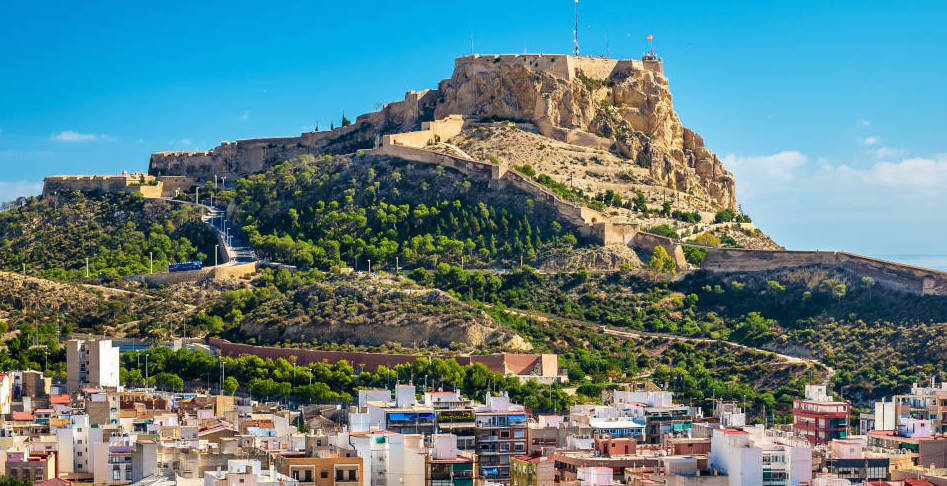
Majestic and beautiful Santa Barbara in Alicante is the most famous castle on the Costa Blanca and the symbol of the capital of the province. It crowns the top of the mountain Benacantil that rises in the city centre.
The fortress of Santa Barbara in Alicante is of Muslim origin and dates to the late IX-th century. The castle can be divided into three zones at different levels, with different characteristics, and built at different times.
The highest area (La Torreta) is the oldest: here is the main tower and ruins of the Muslim era. The middle part dates back to the XVI-th century, and there are located the weaponry yard, the Queen’s citadel, and the Santa Barbara chapel. The last part, the lowest, was built in the XVIII century and is now used as a parking area in front of the castle.
From the castle walls of the Santa Barbara in Alicante, you can enjoy amazing panoramic views of the city and the sea.
The Santa Barbara Castle in Alicante: opening hours
- From October, 1 to March, 31: Monday – Sunday from 10:00 to 20:00.
- April, May, June, September: Monday – Sunday from 10:00 to 22:00.
- July and August: Monday – Sunday from 10:00 to 23:45.
Entrance to the castle is free. It can be reached by car and then you should leave it in the parking lot mentioned above. You can walk up to the castle on foot. There is also an elevator (from the street side Avda. Juan Bautista Lafora, opposite the Postiguet beach, there are signs), which will lift you up to the castle in a matter of seconds.
Operating hours for the elevator: 10:00 to 20:00 (the last ascent at 19:20, the last descent at 19:40).
- Price: €2.7 (free for pensioners).
- The elevator is located here.
El Castillo de Santa Barbara on the map:
The Castle of Banyeres de Mariola (El Castillo de Banyeres de Mariola)

This castle is situated on a hilltop of Águila, in the geographical center of the municipality of Banyeres, and can be reached by passing through an arch-shaped door. The castle was built in the era of the Almohads, in the XIII century, and has undergone many modifications and reconstructions. The main tower (Torre del Homenaje) from the Almohad era remain, there is a museum today, telling the story of the castle and the fest «Moors and Christians». The castle was of major strategic importance in times of wars, and in the XVIII century, during the War of the Spanish Succession, it served as a hiding place for supporters of the King Philip V. From the walls of the castle you can enjoy magnificent views of the neighboring provinces of Albacete, Murcia and Valencia.
Opening hours
Saturday, Sunday, holidays:
- From 11:30 to 13:30 and from 16:00 to 18:00 (from October to May).
- From 11:30 to 13:30 and from 18:00 to 20:00 (June, July, September).
From Tuesday to Sunday:
- From 11:30 to 13:30 and from 18:00 to 20:00 (August).
On holidays: until noon.
Price
- Basic rate: €2.6.
- For pensioners, the unemployed and groups of more than 20 people: €1.3.
- Pass for all museums: €4.5 (standard) and €2.1 (preferential).
El Castillo de Banyeres de Mariola on the map:
The castle-fortress of Santa Pola (El Castillo-Fortaleza de Santa Pola)
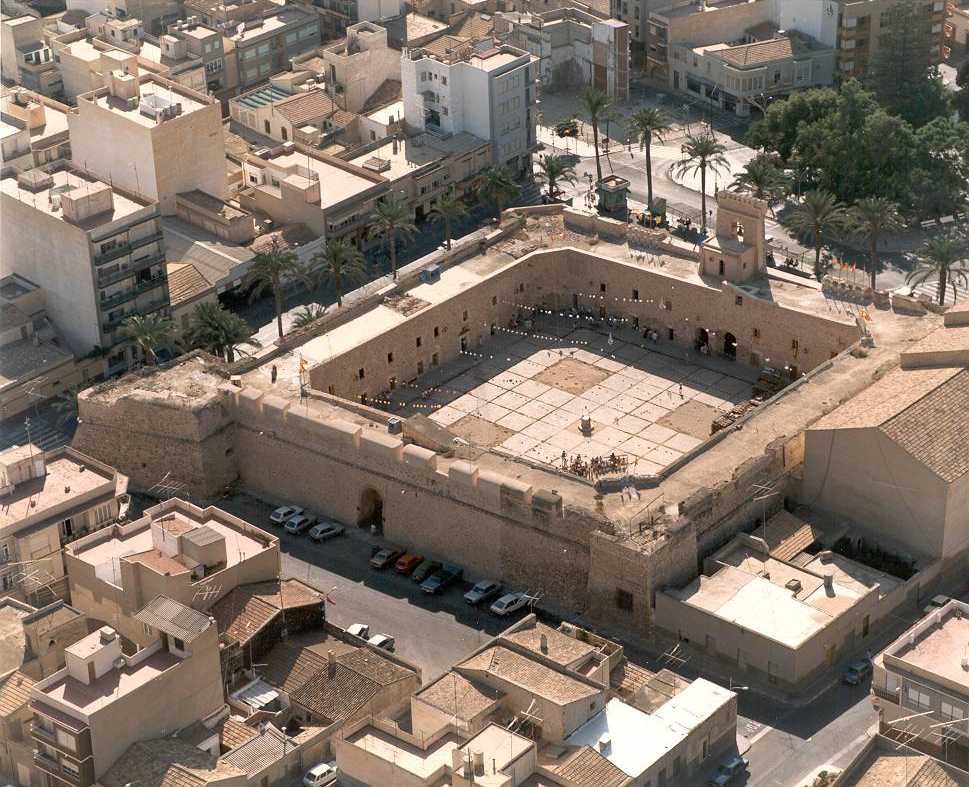
This castle-fortress located in the heart of Santa Pola was built in 1554 as part of «the Action Plan on Coastal Protection of the Kingdom of Valencia». The castle is a fine example of Renaissance architecture of the XVI century. At present, there are a department of the Museum of Maritime and Fishing (Sede de los Museos del Mar y de la Pesca), the municipal exhibition hall, the Chapel of Virgen de Loreto, etc.
Opening hours
Free entry to the weapons yard. Other parts of the castle can be viewed according to the following schedule:
In summer:
- Tuesday – Saturday, from 10:00 to 13:00; from 18:00 to 21:30.
- Sundays and fests: from 11:00 to 13:30.
- Monday is a holiday.
In winter:
- Tuesday – Saturday: 10:00 to 13:00; 16:00 to 19:00.
- Sundays and fests: from 11:00 to 13:30.
- Monday is a holiday.
Price
- Basic rate: €1.6.
- Special rate (students, pensioners): €0.65.
- Free entry: May 18, July 16, October 9, December 6.
El Castillo-Fortaleza de Santa Pola on the map:
The Palace of Altamira in Elche (El Palacio de Altamira)

El Palacio de Altamira or Alcázar de la Señoría in Elche is located in the northeast of the old Muslim town. Its construction has been carried out in three stages: in the era of the Almohads, in the XV, XVI and in the XVIII century. The main tower (El Torre del Homenaje) served in the old days as a refuge for Jaime II, Pedro IV, Alfonso III the Great and the Catholic kings. Today, the Palace hosts the Museum of Archaeology and History of Elche (MAHE) named after Alejandro Ramos Folqués, an archaeologist originally from Elche.
Opening hours
Museum of archaeology and history of Elche (MAHE):
- Monday – Saturday: from 10:00 to 18:00.
- Sundays and holidays: from 10:00 to 15:00.
Guided visits: Saturday and Sunday, from 11:30 to 12:30.
Price
- Basic rate: €3.
- Special rate (students, groups of more than 15 people by appointment): €1.
- Students, pensioners, large families: €1.5.
Free entry: on Sundays, children under 6 years old, holders of the Ayuntamiento de Elche gold card, accredited teachers, disabled persons.
El Palacio de Altamira on the map:
The castles of Alicante – Rio in Aspe (El Castillo del Río)

The Rio castle in Aspe is a fortress of Muslim origin, which was built in the XII century on the top of an embankment located adjoining the confluence of the River Taria with the River Vinalopo. At the moment the castle is in a dilapidated state, but it is of great historical and archaeological value.
El Castillo del Río on the map:
The castles of Alicante – Mola in Novelda (El Castillo de la Mola)
The castle de la Mola is located on a hill, at an altitude of 360 m, 3 km from the town of Novelda. This is a fortress of Muslim origin, which was built at the end of the XII century. In the XIV century, the castle was rebuilt by the Christians, who erected a unique tower here. Since 1931, the castle has been recognized as an object of cultural heritage.
Opening hours
- Open daily.
- In winter: from 10:00 to 14:00 and from 16:00 to 19:00.
- In summer: from 10:00 to 14:00 and from 17:00 to 20:00.
El Castillo de la Mola on the map:
The Castle of Monovar (El Castillo de Monóvar)

This is a castle of the Almohads era, built in the late XII – early XIII century. It is located on the top of a low hill, where artifacts from the Bronze Age were found in the process of archaeological excavations. On the South-Western hillside is placed the historical center of Monovar. The castle was used for proper purpose until the beginning of the XVII century, after which it lost its importance as a fortified structure and later it was abandoned and started to deteriorate.
El Castillo de Monóvar on the map:
The Castle of Elda in Alicante (Castillo de Elda)

In the year 2001, this castle was officially recognized as an object of cultural heritage. It is located on an embankment in the historical center of the town of Elda and it is of Muslim origin (XII – XIII century). In the XIII – XVI centuries, it has served as the feudal castle, and then as the Earl’s fortress. Since the XIX century the castle was abandoned, and at the end of the XX century, with the beginning of archaeological and architectural research, it began to be reconstructed. The castle has great architectural and historical value, and it is well-preserved. The medieval chapel, the parapet, the loophole, and towers deserve particular attention.
Opening hours
- The visit to the castle should have first agreed with the Department of Historical Heritage of the Municipality of Elda (Concejalía de Patrimonio Histórico del Ayuntamiento de Elda).
Castillo de Elda on the map:
The Castle of Petrer (El Castillo de Petrer)
This castle, built by Muslims in the late 12th century, crowns the hilltop located in the historical center of Petrer. From its walls are offered views over the Vinalopo valley. In the XIV century, it passed into the possession of Christians. There are cave-houses near the castle.
Opening hours
- From Tuesday to Sunday: guided visits at 11:00, 12:00 and 13:00.
- From Tuesday to Friday − from Tourist Info or Museo Dámaso Alonso; on Sundays and holidays − from the castle gate).
El Castillo de Petrer on the map:
The Castle of Sax in Alicante (El Castillo de Sax)

This is a very beautiful castle with fabulous views and located on a limestone ridge at an altitude of 500 m above sea level. In the architecture of the castle stand out the tower with a square base of the Almohads era (XII century) in its Northern part and the main tower (el Torre del Homenaje) of 20 meters high of the beginning XIV-th century placed in the South-Western part. In the evenings, the illumination is switched on around the castle, enhancing its «fabulous» appearance.
Opening hours
Sunday:
- In autumn and winter: from 11:00 to 12:00.
- In summer and spring: from 10: 30 to 11:30.
To visit the castle on other days, you need to get permission from the police commissariat. You will give out keys on bail of a valid identity document.
Castillo de Sax on the map:
The Castle of Castalla in Alicante (El Castillo de Castalla)
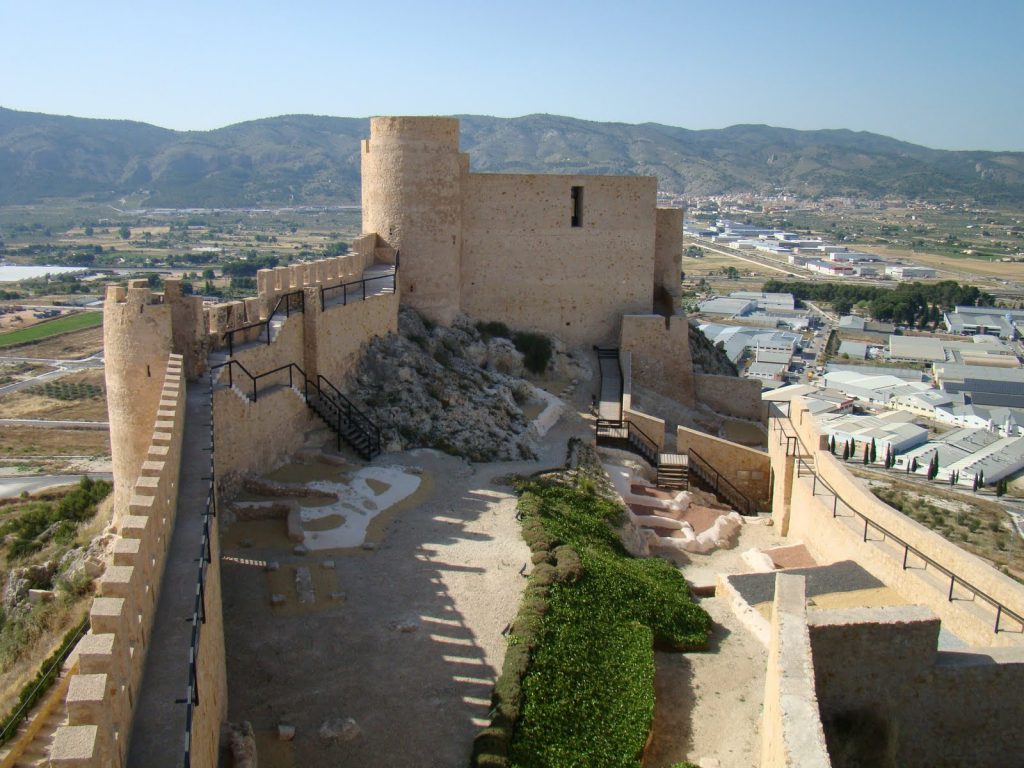
The castle of Castalla is one of the main and best preserved castles of Alicante, recognized as an object of cultural heritage. The castle was built by Muslims in the XI century and rebuilt by Christians in the XIV and XV centuries. The fortress is located on a hill, it was inhabited by people in the second millennium B.C. From one of the towers of the castle – Torre Grossa – you can enjoy magnificent views of the comarca La Hoya de Castalla and the surrounding mountains.
Opening hours
Guided visits:
From January to April
- From Tuesday to Friday – 16:30.
- Saturday, Sunday, holidays – 12:00.
May
- From Tuesday to Friday – 17:00.
- Saturday, Sunday, holidays – 12:00.
From June to August
- Sunday – 11:00.
From May to September
- Night-time visits on Fridays and Saturdays at 22:00 and 23:55.
September and October
- From Tuesday to Friday – 17:00.
- Saturday, Sunday, holidays – 12:00.
November and December
- From Tuesday to Friday – 16:30.
- Saturday, Sunday, holidays – 12:00.
Price
- Basic rate: €3.
- Special rate (students, pensioners, groups over 15): €2.
- Children under 7 years old – free.
Castillo de Castalla on the map:
The Castle of Biar (El Castillo de Biar)
The castle of Biar, placed on the top of a mountain at an altitude of 750 m, is of Muslim origin. It was built in the middle of the XII century and rebuilt many times by the Christians, who conquered it in 1245. The town of Biar, located on the border of the Catholic kingdoms of Castile and Aragon and owned by the Muslims of Murcia, was of major strategic importance, that is why the Muslims decided to build a fortress here. Since the XIV century, the castle has lost its value as a defensive point. On June 4, 1931, the Biar castle was recognized as a national monument. The castle has been wonderfully restored, and from its walls extend wonderful views.
Opening hours
- From Wednesday to Sunday: 10:15 – 13:45.
Price
- €1 (children under 7 years old – free).
Castillo de Biar on the map:
The castles of Alicante – Atalaya in Villena (El Castillo de la Atalaya)
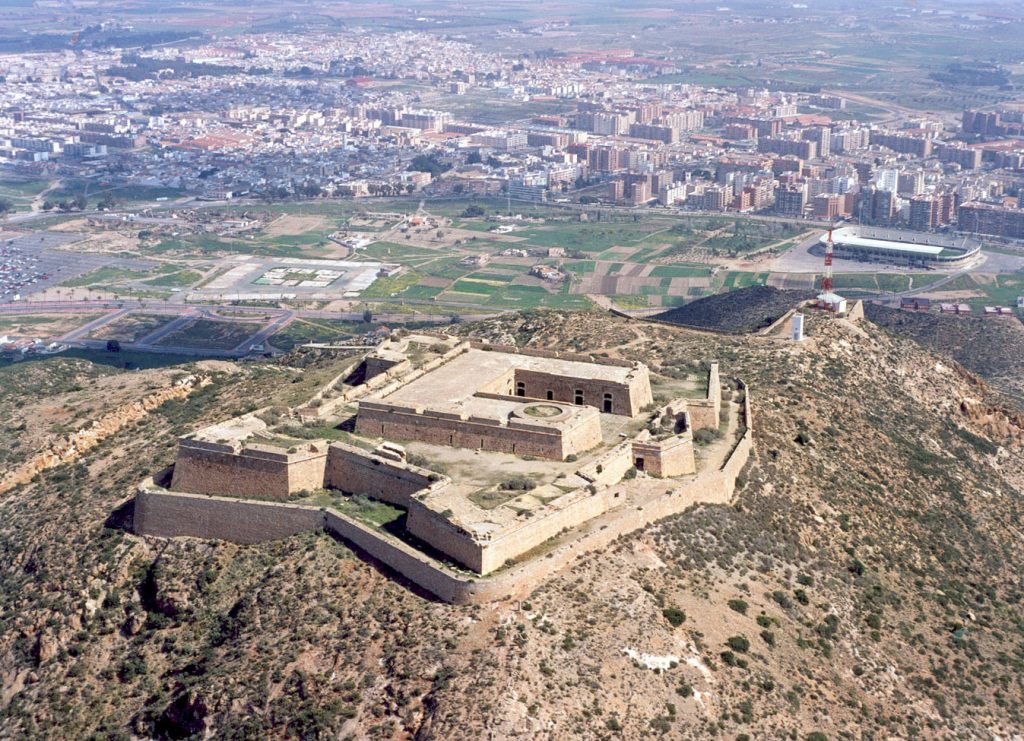
This is one of the best preserved castles in Alicante. The beautiful and majestic castle crowning the town was founded in the XII century on the site of a pre-existing Romanesque fortifications and came under the influence of the Muslims until 1240, when it was conquered by the Catholics. The fortress walls of the castle, crowned with crenellations have in some places up to 4 meters thick. In the XV century, by order of the Marquis of Villena, Juan Pacheco, the outer walls were built around the castle. The main tower of the castle (El Torre de Homenaje) has a height of 27 meters and consists of four levels: the first two of Arabic origin, and the last are Christian’s.
Opening hours
- Morning: from Tuesday to Sunday and on public holidays – guided visits at 11:00, 12:00 and 13:00.
- Evening (except July and August): from Tuesday to Saturday and on public holidays – guided visits at 16:00 and 17:00.
In July and August
- From Tuesday to Saturday and on public holidays – free (without a guide) at 16:00 and 17:00.
- Monday: closed.
Price
- Basic rate: €3.
- Special rate: €1.5.
El Castillo de la Atalaya on the map:
The Ayala castle in Cox (El Castillo de Ayala or Palacete de Cox)
The main attraction of the town of Cox is its castle of Muslim origin, which is one of the oldest not only in the Valencian community, but also throughout Spain. The castle has been restored. It is located on the top of a hill with a height of 80 m, archaeological excavations on the slopes have recovered artifacts from different eras, since the Bronze age. Beautiful views of the Vega Baja del Segura Comarca are offered from its walls.
El Castillo de Ayala on the map:
The palace-fortress of the Marquis of Two Waters in Onil (Palacio Fortaleza del Marques de Dos Aguas)

This beautiful fortress was built by order of Ramon de Vilanova, Baron Hoya de Castalla and Senor of Onil. The order for construction was given in 1539, and construction was completed in 1614. The Palace was built in the Gothic-Renaissance style. Today it houses an exhibition hall that tells about the traditional festivals of the municipality.
Opening hours
- From Tuesday to Sunday: from 10:00 to 14:00.
- Saturday evenings: from 17:30 to 20:00.
- Monday: closed.
- Entry is Free
El Palacio Fortaleza del Marques de Dos Aguas on the map:
The castles of Alicante – Barxell in Alcoy (El Castillo de Barxell)
The castle, built in the XIII century, has a Christian origin. It was intended to control the Muslim population living in the town of Alcoy and surroundings. The castle is located on the top of a rocky hill surrounded by a pine forest. Over the centuries, the castle changed hands, was rebuilt and reformed. Since 1964, it has been in an abandoned state, and in 1996 it was declared as a site of cultural heritage. In July 2014, the castle was purchased by journalist and businessman Xavi Martinez Caravaka and works have begun on the restoration.
El Castillo de Barxell on the map:
The castles of Alicante – Perputxent in Lorcha (El Castillo de Perputxent)
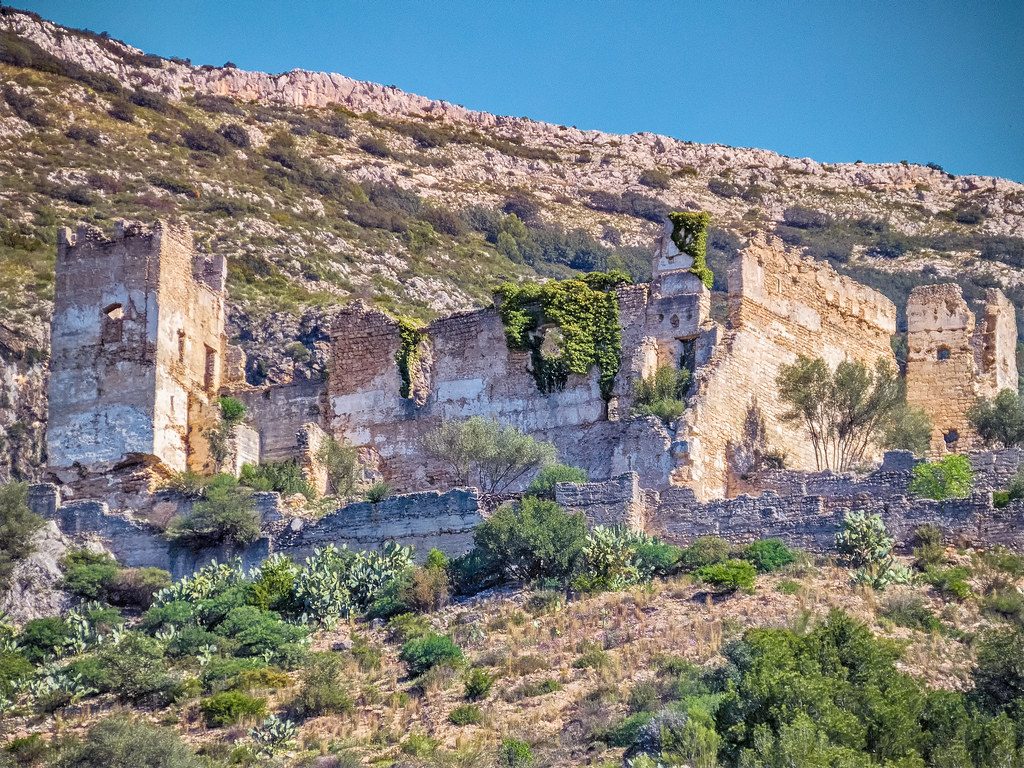
The castle of Perputxent is just 1 kilometer from the town of Lorca, it has a Muslim origin and was built in the late XII – early XIII century. Within its walls lived the famous commander of the Arab-Moors, Al-Azraq. The castle is situated on a high rock near the mountain range Sierra de la Solana. From the highest point of the castle, located at an altitude of 380 m, you can enjoy views of the Perputxent valley and the river of Serpis. The castle is open to the public but come up there is possible only from the South side of the mountain.
El Castillo de Perputxent on the map:
The Castle of Polop (El Castillo de Polop)

The Castle of Polop is of Muslim origin and dated by the XII century. In its time, it was an important strategic point of the region. Today, the castle is in a dilapidated state, but it is interesting to visit for those who are partial to antiquity and history: here you can see rests of the original structure of the castle, belonging to the Muslim era.
You can find out more about the town of Polop here.
El castillo de Polop on the map:
The Castle of Guadalest (El Castillo de Guadalest)
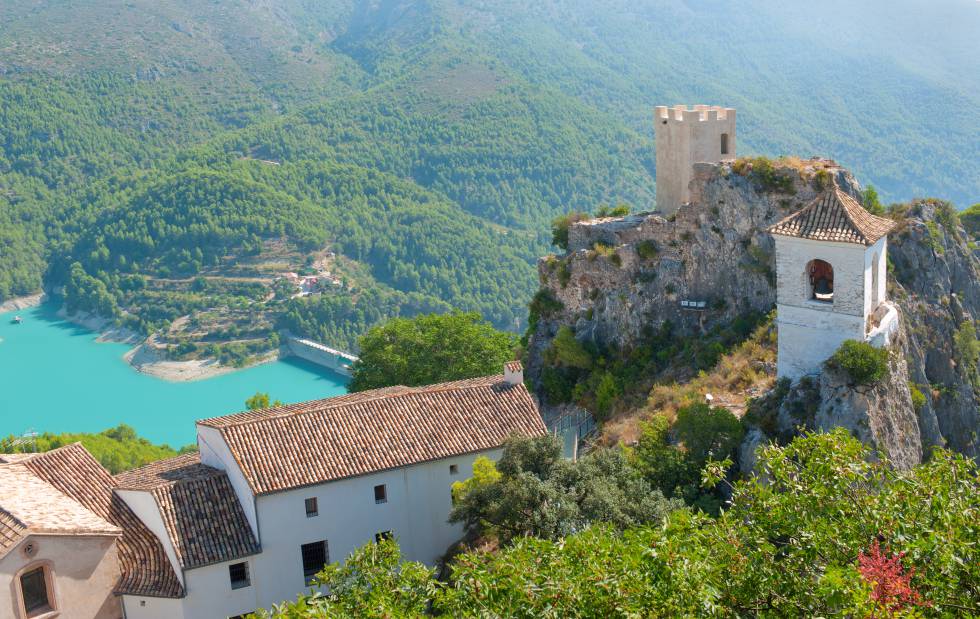
The small picturesque town of Guadalest is situated high in the mountains and recognized as one of the most beautiful in Spain, beening very popular among tourists. One of its main attractions is the 11th-century fortress of Muslim origin, located on a cliff top, at the highest point of the municipality. The castle of Guadalest was partially destroyed by the earthquakes of 1644 and 1748. It also was affected by bombings in 1708 during the War of the Spanish Succession.
El Castillo de Guadalest on the map:
The Castle of Denia in Alicante (El Castillo de Dénia)

The castle of Denia is of Arabic origin, built in the X-XI century and located in the heart of the town, in the quarter of Les Roques. In 1244, after the conquest of Denia by Jaime I, it passed into the hands of Christians. The architecture of the castle stands out the tower of Torre del Mig, dated by the XI century. You can go up to the castle on foot or by tourist train (cars were banned from entering a few years ago).
Opening hours
- From November to March: 10:00 – 18:00.
- From April to May: 10:00 – 19:00.
- June: 10:00 – 19:30.
- From July 1 to September 15: 10:00 – 00:30.
- From 16 to 30 September: 10.00 – 20.00.
- October: 10:00 – 18:30.
Price
- For residents of Denia and children under 8 years: free.
- The basic rate is €3.
- For children from 8 to 16 years – €1.
- For students and pensioners, as well as for groups of more than 10 people – €2.
El Castillo de Dénia on the map:
Have no fear to take your time to explore these beautiful castles of Alicante! By the way, there is an interesting fact: small palaces and castles of Alicante are sometimes put up for sale, so if you have a certain amount, you can easily become the owner of such an unusual property in Spain . If you are not looking for a castle, but just high-quality housing in Spain, whether it is secondary real estate or new buildings, look at our catalog and feel free to contact our specialists if you have questions about property in Spain.



